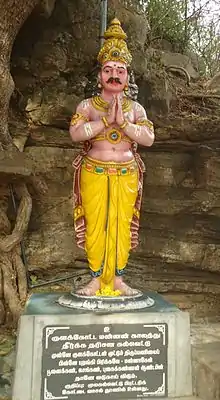| Kulakkottan | |
|---|---|
 Sculpture of Kulakkottan | |
| Reign | c. 5th Century CE |
| Dynasty | Chola Dynasty |
| Father | Vararamatevan[1] |
| Religion | Hindu |
| Chola Kings and Emperors |
|---|
| Interregnum (c. 200 – c. 848 CE) |
| Related |
Kulakkottan (Tamil: குளக்கோட்டன்) was an early Chola king and descendant of Manu Needhi Cholan who was mentioned in chronicles such as the Yalpana Vaipava Malai and stone inscriptions like Konesar Kalvettu. His name Kulakkottan means 'builder of tank and temple'.[2]
Kulakkottan was the son of Vararamatevan, said to have been ruler of Chola Nadu and Madurai.[1] The historian and author, Mudaliyar Rasanayagam states that Vararamatevan and Kulakkottan arrived in Trincomalee during the reign of King Pandu of Anuradhapura.[3] Vararamatevan found the Koneswaram temple destroyed by the Buddhist King Mahasena. He decided to restore it, a work which was later continued by his son.[4] Kulakkottan was credited with the restoration of the ruined Koneswaram temple and for building Kantale Dam at Trincomalee in 438 CE, and the Munneswaram temple of the west coast. He is known as the royal who settled ancient Vanniyars in the east of the island of Eelam.[5][2]
See also
References
- 1 2 Patmanātan̲, Ci (2006). Hindu temples of Sri Lanka. Colombo: Thirukketheeswaram Temple Restoration Society & Kumaran Book House. pp. 68−70. ISBN 9789559429913.
- 1 2 Schalk, Peter; Nākacāmi, Ira (Irāmaccantiran̲) (2002). Schalk, Peter; Vēluppiḷḷai, Āḷvāppiḷḷai (eds.). Buddhism among Tamils in pre-colonial Tamil̲akam and Īl̲am: Prologue − The Pre-Pallava and the Pallava period. Acta Universitatis Upsaliensis; Historia religionum: 19−20. Vol. 1. Uppsala: Uppsala Universitet. pp. 159, 503. ISBN 9155453570. [Citing: Pillay, K. K. (1963). South India and Ceylon].
The Tamil stone inscription Konesar Kalvettu details King Kulakottan's involvement in the restoration of Koneswaram temple in 438 A.D.
- ↑ Rasanayagam, Mudaliyar C. (1993) [First published 1926]. "VI. Sources and Synchronisms". Ancient Jaffna: Being a research into the history of Jaffna from very early times to the Portuguese period. New Delhi: Asian Educational Services. pp. 227–271. ISBN 81-206-0210-2. Retrieved 6 November 2022.
- ↑ Vigneswaran, K. (2006). "Tirukkonesvaram". In Patmanātan̲, Ci (ed.). Hindu temples of Sri Lanka. Colombo: Thirukketheeswaram Temple Restoration Society & Kumaran Book House. ISBN 9789559429913.
- ↑ Hellmann-Rajanayagam, Dagmar (1994). "Tamils and the meaning of history". Contemporary South Asia. Routledge. 3 (1): 3–23. doi:10.1080/09584939408719724.
Further reading
- Jayawardhana, Jayashantha (11 September 2022). "The Koneswaram Temple". Sunday Observer. (A trip to Trincomalee by train – Part 7). Retrieved 23 September 2022.
- Pieris, Kamalika (31 July 2009). "Ancient and medieval Hindu temples in Sri Lanka". Daily News. Lakehouse Newspapers. Retrieved 23 September 2022.
- Pillay, K. K. [K.P.K.] (1963). South India and Ceylon. Madras [Chennai]: University of Madras. OCLC 250247191. [NOTE: The author "Kolappa Pillay Kanakasabhapathi PILLAY", is mostly cited as "K. K. Pillay" or sometimes, in error, as "K. Pillay & K. Pillay"].